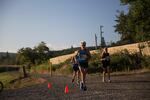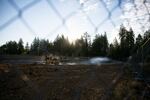About an hour northwest of Portland, near the northern terminus of the Banks-Vernonia State Trail, are a running track and an old blue grandstand.
The track at Greenman Field in Vernonia doesn’t look like a normal track because it isn’t a normal track. It has three turns and no lanes. From above, it looks like a rounded triangle — a midcentury design that has somehow lasted into 2018.
The track doesn’t meet national or international specifications and the grandstand is falling apart.
However, when the city announced late last summer plans to demolish the Greenman Field grandstand, a buzzsaw of opposition was there to meet it.
“When you roll into town, it says, ‘Welcome to Historic Vernonia,’” said Del Allen, an ardent supporter of preserving the grandstand. If it’s torn down, Allen said, “you might as well take ‘historic’ off that sign.”
It’s hard to believe anyone has played sports at Greenman Field for at least 20 years.
Stiff-stemmed dandelions burst from the track’s curbs, making it hard to tell where the weeds end and the track begins.
Yet it was still home to the Vernonia Mighty Loggers last school year — sort of.
“Track and field didn’t have a home meet — ever,” said Gordon Jarman, athletic director for the Vernonia School District.
Those days will soon be over.
Construction began on new outdoor athletic facilities this summer. The district anticipates they’ll be mostly finished by this fall. Hardly anyone in the town of 2,200 seems to be against new grounds for the Loggers.
But for people like Allen, destruction of the grandstand takes away one of the last vestiges of Vernonia’s logging history and a symbol of the city’s unlikely perseverance.
Like many in Vernonia, Allen is a commuter to the Portland area where he works nights in construction.
“If you don’t commute to town, you’re a logger,” he half-joked. Relatively few loggers are left in Vernonia.
For a few decades, Vernonia produced some of the most coveted old-growth Douglas fir lumber in the world. In 1923, it briefly became the fastest-growing city in Oregon, according to the Oregon Historical Society.
After the mill closure in 1958, Vernonia, like so many other mill towns, struggled to find a new identity. The city was left devoid of any major industry in a flood-prone location.
One of the first things to come to town in the mill’s wake was the Greenman Field grandstand. The Vernonia Lions Club gifted the old-growth lumber bleachers to the school district in 1960. It was a popular community gathering place.

A cracked beam in the Greenman Field grandstand makes the roof sag like a wet paper towel.
Bradley W. Parks / OPB
For a wooden structure in one of the state’s rainiest places, the grandstand has held up well.
However, Jarman said, “wood has a lifetime in Oregon.”
The grandstand remains closed to the public after it was condemned by the city.
The press box windows are smashed. Sparrows nest in the gutters. A cracked beam makes the roof sag like a wet paper towel.
Greenman Field is also inside the flood plain, situated near the intersection of Rock Creek and the Nehalem River. Catastrophic floods hit Vernonia in 1996 and 2007, putting Greenman Field and the adjacent school buildings under more than 6 feet of water.
Some in the Oregon Legislature questioned whether Vernonia should even rebuild after the floods. Allen calls it the land “that nobody else wanted.”

Sparrows on the roof of the Greenman Field grandstand.
Bradley W. Parks / OPB
Two years after the 2007 flood, Vernonia passed a $13 million bond to help construct a new school out of the flood plain. The building was completed in 2012. It houses grades K–12 and is LEED-Platinum certified.
The district had planned to build outdoor athletic facilities with the new school, but cut them from the budget, temporarily keeping sports teams at Greenman Field.
The city later proposed demolishing the Greenman Field grandstand, saying the estimated $100,000 to save it was too high. City Council meeting minutes from March 2018 read:
“This was a tough decision for everyone who grew up here. The stadium was built to fill a need. That need is now up at the new school.”
Jarman said it’s uncertain when the new stadium in Vernonia will get covered bleachers.
Beyond the historical significance, supporters of saving the Greenman Field grandstand say the structure can still serve a purpose in the meantime. Allen envisions hosting homecoming football games at Greenman and using it for the annual logging festival. The track could be used as a start or finish to the Vernonia Marathon and other races.

Runners in the Vernonia Marathon pass by Greenman Field on the Banks-Vernonia State Trail.
Bradley W. Parks / OPB
The track has its odd shape to fit fields for baseball and football within. St. Helens Middle School in Oregon still has a three-turn track on its campus too. Old Yankee Stadium in New York even had a three-turn running track until the early 1950s.
But the design went out of style (and regulation) and three-turn tracks are now a rarity.
Vernonia High School alumnus and former track team captain Michael Calhoun remembers the red dust runners kicked up on the cinder track at Greenman.
“The incentive was to be the fastest in front so you’re not eating everyone’s dust,” he said.
Vernonia is about 150 miles north of the rubble pile that was Historic Hayward Field in Eugene. People there had tried to save Hayward's iconic grandstands to no avail.
In Vernonia, like in Eugene, the battle over the Greenman Field grandstand comes down to the preservation of history versus long-term viability.
At the University of Oregon, with big-name private donors like Phil and Penny Knight, it was hardly a question of if Historic Hayward's grandstands would come down, but when. The Hayward rebuild was part of a predictable pattern of university modernization.
Vernonia is different. It’s a small town where even just a few loud voices can effect change.
Calhoun, now a University of Oregon student, opposed what seemed like a rushed demolition of the Hayward grandstands and feels similarly about Greenman Field. But he said the Vernonia grandstand shouldn’t be saved for the sake of being saved.
“It shouldn’t be used to feed nostalgia,” Calhoun said. “There should be a use there.”
A work session with grandstand supporters and City Council is scheduled for the end of July, where they will likely decide the structure’s fate.

Workers install a new oblong track behind the Vernonia school building.
Bradley W. Parks / OPB
Calhoun said, regardless of the city’s decision, he would like to see Greenman Field historically recognized in some way.
The grandstand was built by volunteers and Allen thinks it can be rebuilt by volunteers for much less than the city’s initial estimate. Doing so, he said, would be to honor Vernonia’s survivalist legacy.
“It’s respect for the people who grabbed their hammers,” he said, “and built the whole damn thing as a gift to the school.”



